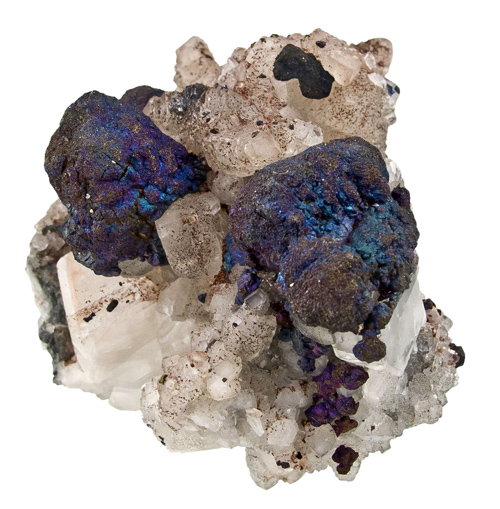The Mineral bornite

Bornite is an ore mineral of copper, and is known for its iridescent tarnish. "Peacock Ore", which is sold to amateur mineral collectors and tourists, is often labeled as a variety of Bornite. However, most Peacock Ore in reality is Chalcopyrite treated with acid, which produces a strongly-colored iridescent tarnish. Bornite is named for Ignatius von Born, an Austrian mineralogist and paleontologist.
Color
Copper-red to yellowish brown on fresh surfaces. Quickly tarnishes to a multicolored purple, blue, and red.
Crystal System
Orthorhombic
Properties
Streak
Dark gray to black |
Hardness
3 - 3.5 |
Transparency
Opaque |
Specific Gravity
4.9 - 5.3 |
Luster
Metallic |
Cleavage
Indiscernible |
Fracture
Conchoidal |
Tenacity
Brittle |
Other ID Marks
Tarnishes to an iridescent purple, blue, and red. |
Crystal Habits
Bornite forms as isometric crystals at high temperatures, but when
it cools down to normal temperatures it crystallizes in the
orthorhombic system. However, the crystals retain their original
isometric crystals. Crystals are rare, and are in cubic or dodecahedral form. Octahedral shaped crystals are extremely rare. Bornite occurs mostly massive, as well as in groups of tiny crystals and globular.
Varieties
-
Term used to describe Chalcopyrite or Bornite with a colorful iridescent tarnish effect, usually artificially enhanced with acid. Most Peacock Ore is sold as Bornite, when in fact it usually produced from acid-treating Chalcopyrite.
Uses
Bornite is a common copper bearing mineral, and is used as an ore of copper when found in copper deposits.
Noteworthy Localities
The largest and most distinct crystals of Bornite have come from
Dzhezkazgan, Kazakhstan. Good crystals also come from Shaba, Congo
(Zaire); and from the Mangula Mine in Mhangura, Zimbabwe. The province of Cornwall, England has produced many Bornite specimens, including some crystallized examples (especially in the Carn Brea Mine). Nice crystals as well as massive form come from San Martin, Zacatecas, Mexico.
Large quantities of Bornite, mostly in massive form, have been extracted from the Arizona copper mines, particularly the Magma mine in Superior, Pinal Co.; and the Copper Queen Mine in Bisbee, Cochise Co. Rare crystals have come from Butte, Silver Bow Co., Montana, where much massive material is also found. Small crystals were also once found at the copper mine at Bristol, Hartford Co., Connecticut.
Large amounts of Bornite have come from the Evergreen mine near Apex, Gilpin Co., Colorado, and the Flambeau Mine, Ladysmith, Rusk Co., Wisconsin. Bornite has also has been found in the White Pine mine, Ontonagan Co., Michigan; the French Creek mine, St. Peters, Chester Co., Pennsylvania; Luzerne Co., Pennsylvania; and the Chimney Rock Quarry, Bound Brook, New Jersey.
In Canada, Bornite occurrences include the Marble Bay mine, Texada Island, British Columbia, and the Acton mine, Bagot Co., Quebec.
Distingushing Similar Minerals
Chalcopyrite - Different crystal form, usually lighter in color, weaker natural tarnish.
Pyrrhotite - Harder, attracted to magnetic fields, no tarnish.
Nickeline - Harder, higher specific gravity, lacks tarnish.